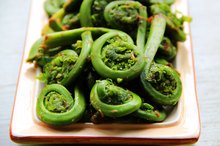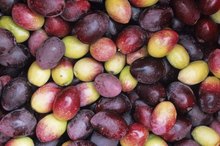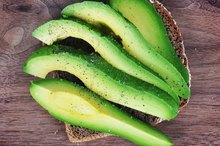What does fact checked mean?
At Healthfully, we strive to deliver objective content that is accurate and up-to-date. Our team periodically reviews articles in order to ensure content quality. The sources cited below consist of evidence from peer-reviewed journals, prominent medical organizations, academic associations, and government data.
The information contained on this site is for informational purposes only, and should not be used as a substitute for the advice of a professional health care provider. Please check with the appropriate physician regarding health questions and concerns. Although we strive to deliver accurate and up-to-date information, no guarantee to that effect is made.
Vitamins in Olives
Olive trees, or Olea europaea, are native to the eastern Mediterranean, but thrive anywhere with a similar climate. A bitter substance in raw olives renders them inedible, so they require processing. Green olives are harvested unripe, then processed. Olives turn black when ripe, but not all bottled or canned black olives were harvested ripe. Processing can also turn unripe olives black. Regardless of color, all olives contain valuable vitamins.
B-Complex Vitamins
Olives contain thiamin, or vitamin B-1, niacin, or vitamin B-3, pantothenic acid, or vitamin B-5 and vitamin B-6. The human body uses these vitamins to convert carbohydrates from food into glucose for energy. Beyond this, each B vitamin has a separate function and the body requires different amounts of each daily. The most prevalent B vitamin in olives is niacin, which is important for hormone production. The second most abundant, pantothenic acid, is essential for red blood cell production.
- Olives contain thiamin, or vitamin B-1, niacin, or vitamin B-3, pantothenic acid, or vitamin B-5 and vitamin B-6.
- The most prevalent B vitamin in olives is niacin, which is important for hormone production.
Vitamin E
Fiddlehead Ferns Nutrition
Learn More
Fat-soluble vitamin E is among the vitamins in olives. This vitamin is an antioxidant, helping protect cells from damage. It's also vital for the creation of red blood cells. You can get 1.65 mg of vitamin E from 100 g, or 3.5 oz., of canned ripe olives, according to the U.S. Department of Agriculture's Nutrient Data Laboratory 1. People older than age 14 need 15 g of vitamin E daily, so eating olives will help you somewhat in getting that amount.
- Fat-soluble vitamin E is among the vitamins in olives.
- People older than age 14 need 15 g of vitamin E daily, so eating olives will help you somewhat in getting that amount.
Vitamin A and Beta Carotene
A 100-g serving of canned ripe olives provides 403 IU of vitamin A and 237 mcg of beta carotene. Vitamin A is important for healthy eyes, a properly functioning immune system and red blood cell production. Beta carotene, a compound the body converts into vitamin A, has similar uses in the body as vitamin A.
Vitamin C
How Much EPA & DHA Are in Chia Seeds?
Learn More
A small amount of vitamin C is present in olives. This antioxidant helps the body produce and repair tissues, including skin, collagen, tendons and blood vessels. A 100-g serving of olives contains only 0.9 mg of vitamin C. The recommended daily intake of this vitamin is 90 mg a day for men and 75 mg daily for women, according to the University of Maryland 234. So olives provide only a fraction of the vitamin C you need daily.
- A small amount of vitamin C is present in olives.
- So olives provide only a fraction of the vitamin C you need daily.
Vitamin K
Although leafy green vegetables are the richest sources of vitamin K, 100 g of olives contains 1.4 mcg of this vitamin, according to the Nutrient Data Laboratory 1. The primary function of vitamin K is to ensure normal blood coagulation. Because it helps the body use calcium, it's also important for sufficient bone density. Vitamin E, also found in olives, helps your body use vitamin K.
- Although leafy green vegetables are the richest sources of vitamin K, 100 g of olives contains 1.4 mcg of this vitamin, according to the Nutrient Data Laboratory 1.
Related Articles
References
- USDA Nutrient Data Laboratory: Olives, Ripe, Canned, Small-Extra Large
- University of Maryland: Vitamin B-3
- University of Maryland: Vitamin B-5
- Oregon State University: Vitamin A
- Olives, green. FoodData Central. U.S. Department of Agriculture. Published April 1, 2020.
- Olives, black. FoodData Central. U.S. Department of Agriculture. Published April 1, 2020.
- Omar SH. Oleuropein in olive and its pharmacological effects. Sci Pharm. 2010;78(2):133-54. doi:10.3797/scipharm.0912-18
- Schwingshackl L, Hoffmann G. Monounsaturated fatty acids, olive oil and health status: a systematic review and meta-analysis of cohort studies. Lipids Health Dis. 2014;13:154. doi:10.1186/1476-511x-13-154
- Montoro BP, Benomar N, Lavilla Lerma L, Castillo Gutiérrez S, Gálvez A, Abriouel H. Fermented Aloreña table olives as a source of potential probiotic strains. Front Microbiol. 2016;7:1583. doi:10.3389/fmicb.2016.01583
- La Fata G, Weber P, Mohajeri MH. Effects of vitamin E on cognitive performance during ageing and in Alzheimer's disease. Nutrients. 2014;6(12):5453-5472. Published 2014 Nov 28. doi:10.3390/nu6125453
- Omar SH. Mediterranean and MIND diets containing olive biophenols reduces the prevalence of Alzheimer's disease. Int J Mol Sci. 2019;20(11). doi:10.3390/ijms20112797
- McMacken M, Shah S. A plant-based diet for the prevention and treatment of type 2 diabetes. J Geriatr Cardiol. 2017;14(5):342-354. doi:10.11909/j.issn.1671-5411.2017.05.009
- Esteve C, Montealegre C, Marina ML, García MC. Analysis of olive allergens. Talanta. 2012;92:1-14. doi:https://doi.org/10.1016/j.talanta.2012.01.016
- Tang S, Avena-Bustillos RJ, Lear M, et al. Evaluation of thermal processing variables for reducing acrylamide in canned black ripe olives. J Food Engineer. 2016;191:142-130. doi:10.1016/j.jfoodeng.2016.07.011
Writer Bio
Nicole Langton has been a professional writer for over 10 years. She began writing for a natural health company where she developed a deep interest in nutrition and natural treatments. Langton earned a Bachelor of Arts in east central European studies as well as a certificate in English language to teach to adults.









